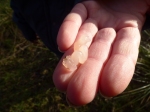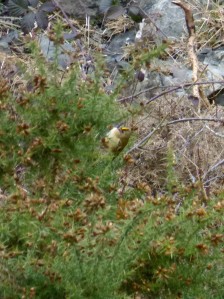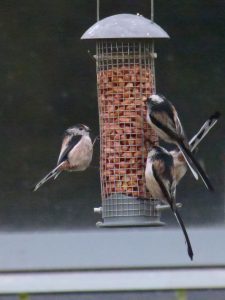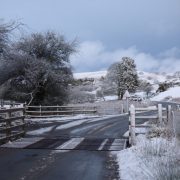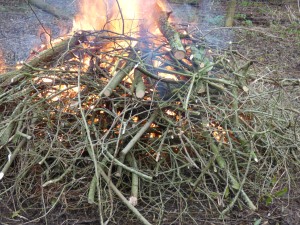Catching Up pt 3
As this blog catches up with the present day, I can reveal even more exciting wildlife sightings. Over at my local park, I spotted my first Mistle Thrush (Turdus viscivorus) in months – whilst my dad recently saw a Fieldfare (Turdus pilaris) there. Spring is started to appear, as buds begin to burst forth and the scent of blossom from unfurling flowers is carried on that still slightly chilly breeze.
- Mistle Thrush (Turdus viscivorus)
I spotted my first non-bumblebee bee (as yet unidentified, I’m not much good [yet] if it isn’t a bumblebee!) of 2015 in the park, feeding on this yellow flower (as yet unidentified, it’s in the list of plants to ID) in the sunlight – wilfully ignoring both myself taking photos and a number of dogs running about and barking (a good game was going on at the time you see).
I have also checked back on the fungi that I saw growing previously – you can see how much it has dried out!
A quick trip down to Dorset saw me getting a number of new year ticks – Blackcap (see below), Brent Goose, Oystercatcher and more, as well as a few lifers!
A tip-off from Glen at the Portland Bird Observatory led to myself and Sean having a wander through the lovely Broadcroft Quarry (do you remember my fantastic visit last year?) in search of the Widow Iris aka the Snake’s Head Iris (Iris tuberosa). As well as being a lovely plant to look at, it was also rather fascinating to watch the bees as they landed on the flower and crawled deep into the funnel to feed. You can see in the second (slightly blurry) photo, that they get rather covered in pollen!
- Blackcap, male (Sylvia atricapilla)
- Appearing from the depths
- A little blurry
- Can you spot it?
- Sean takes a closer look
As mentioned, I saw my first Blackcap (Sylvia atricapilla) of the year at Portland Bird Observatory. What a stunning bird it is! It’s a male – you can tell because his cap is black whereas the female’s cap is red-brown in colour.
A very exciting lifer for me was seeing a Firecrest (Regulus ignicapillus) – again from the terrace at PBO! It was not long before I needed to head off when Glen pointed it out. And not just one, but two! Fantastic! I’d heard Firecrest before, and seen their close relative the Goldcrest (Regulus regulus), but had never actually seen one so I was ecstatic!
- Blackcap, male (Sylvia atricapilla)
- Against the sky
On a short visit to Cambridgeshire, I kept an eye on the garden whilst baking (scones btw, they were delicious!). After having seen my first Mistle Thrush (Turdus viscivorus) in months only a few days previously, I was very pleasantly surprised to see another one so soon! More so because after a few attempts, I managed to get a decent photo of it despite (1) being at a distance, (2) taking the photo through a window, and (3) having obstacles in the way!
Not long after, I enjoyed viewing a female Blackbird (Turdus merula) atop the hedge. She was all fluffed up and evidently sunning herself – I don’t blame her! As the sun started to fade, there was an odd-looking bird in the garden. It was a Blue Tit (Parus caeruleus), but it seemed to have a deformity – a huge lump on the back of its neck – and possibly a bald head? It was hard to tell in the light, and the photo doesn’t help much. Has anyone else seen anything like this in Blue Tits? It didn’t seem to be too effected by its misfortune – it was feeding fine.
- Firecrest (Regulus ignicapillus)

















































































